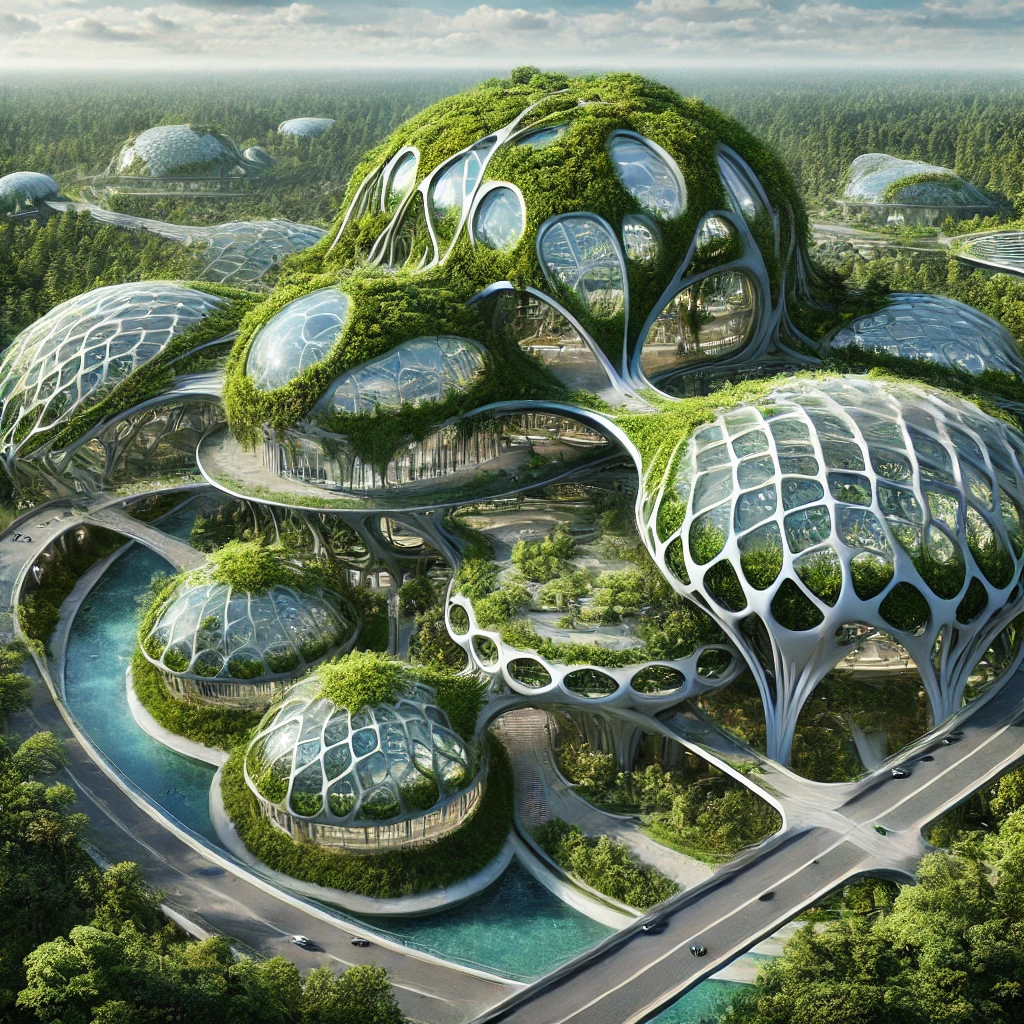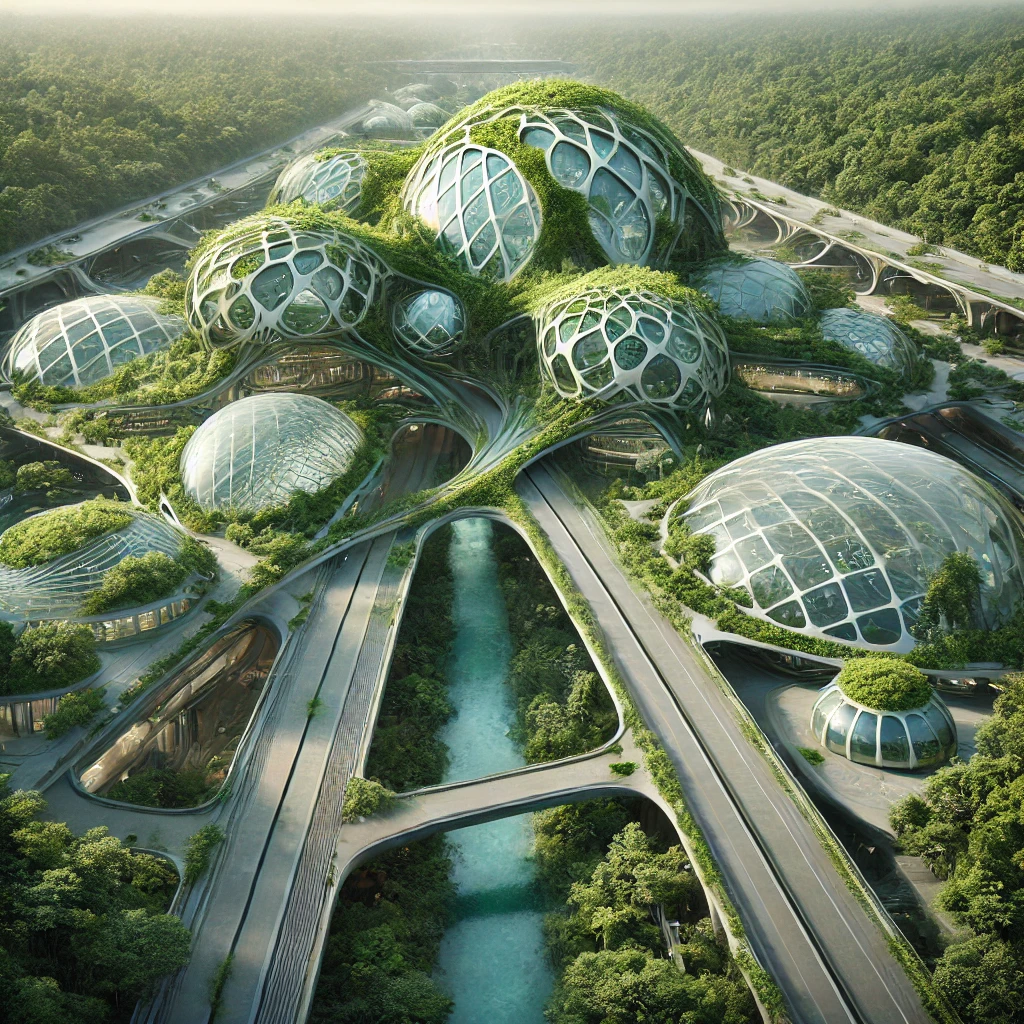

Introduction:
In the realm of futuristic architecture, the concept of blending urban environments with natural ecosystems has taken a bold leap forward. The two captivating visuals presented here showcase a revolutionary design known as Biophilic Domes. These interconnected dome structures, resembling organic clusters in a forested landscape, exemplify the potential of merging cutting-edge design with sustainability. This article delves into the intricacies of these domes, exploring their design philosophy, technological innovations, and their implications for the future of architectural development.
Biophilic Design: Bringing Nature into Urban Spaces
Biophilic architecture is centered around the principle of bringing natural elements into built environments to enhance the connection between humans and nature. The Biophilic Domes, as depicted in these images, serve as a shining example of this philosophy. With their smooth, organic shapes and transparent facades, these domes seamlessly blend with the surrounding forest, creating a symbiotic relationship between structure and nature. The integration of greenery within and around the domes not only enhances aesthetic appeal but also improves air quality and offers a tranquil environment for inhabitants.
Design Features: Exploring the Organic Futurism of the Domes
1. Nature-Inspired Structural Forms:
The domes take inspiration from natural elements like honeycombs and bubbles, forming interlinked patterns that create a visually stunning and functional urban layout. The lattice-like framework supports the weight of the domes, while the transparent glass panels offer expansive views of the lush surroundings. The curvature of each dome is carefully designed to optimize light penetration, creating a naturally illuminated space within.
2. Sustainable Ecosystem Integration:
Each dome structure is enveloped in vegetation, making it a living, breathing component of the urban ecosystem. The use of green roofs and vertical gardens not only provides thermal insulation but also acts as a natural air purifier, absorbing pollutants and releasing oxygen. The domes are designed to support a diverse range of flora, creating mini-ecosystems that promote biodiversity within the cityscape.
3. Elevated Pathways and Water Channels:
The interconnected nature of the domes is further enhanced by a network of elevated pathways and water channels. These water bodies not only serve as aesthetic elements but also function as a sustainable water management system. Rainwater is harvested, filtered, and redistributed throughout the structure, ensuring that the domes maintain a self-sustaining water cycle.
4. Transparent Facades and Smart Technology Integration:
The transparent domes are equipped with smart glass technology that regulates light and temperature, creating a comfortable indoor environment. This adaptive façade system reduces the need for artificial lighting and climate control, further lowering the energy footprint. Integrated sensors monitor environmental conditions, adjusting the building systems in real-time to optimize energy efficiency.

Impact on Future Architectural Practices
The Biophilic Domes represent more than just a futuristic aesthetic; they embody a shift in architectural thinking towards sustainable, human-centered design. By integrating nature into the core of the urban environment, these domes challenge the conventional boundaries between indoor and outdoor spaces. The approach promotes mental well-being, encourages physical activity, and fosters a greater appreciation for nature within urban settings. As cities around the world grapple with issues of overcrowding and environmental degradation, the Biophilic Domes offer a model for how future developments can prioritize both human and ecological health.
Conclusion: The Next Evolution in Architectural Design
The images of these futuristic domes present a vision of what our cities could look like in the near future — a harmonious blend of advanced technology, innovative design, and nature. These structures not only redefine the concept of urban living but also serve as a testament to the potential of architecture to contribute to a more sustainable and livable future. As we move forward, embracing biophilic design principles will be key to creating cities that are not just smart and efficient but also deeply connected to the natural world.
- Islamic Futuristic Architecture: Blending Tradition with Modernity for Sustainable Cities
- Futuristic Architecture and Eco-City Innovations: Design Ideas and Tips for Architects
- Elevate Your Space with Modern Egg Chair Designs
- Modern Homes and Interior Design Tips: A Guide for Homeowners and Designers
- Modern Home Architecture: Design Tips for Builders, Architects, and Investors
